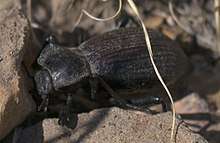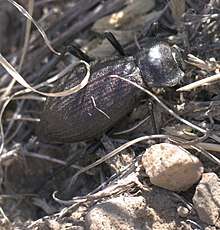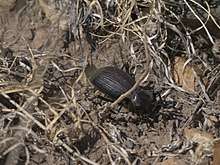Philolithus
Philolithus is a genus of darkling beetles in the family Tenebrionidae. There are about seven described species in Philolithus.[1][2][3]


| Philolithus | |
|---|---|
 | |
| Scientific classification | |
| Kingdom: | Animalia |
| Phylum: | Arthropoda |
| Class: | Insecta |
| Order: | Coleoptera |
| Family: | Tenebrionidae |
| Tribe: | Asidini |
| Genus: | Philolithus Lacordaire, 1858 |
Species
These seven species belong to the genus Philolithus:
- Philolithus actuosus (Horn, 1870) b
- Philolithus aeger b
- Philolithus densicollis (Horn, 1894) g b
- Philolithus elatus b
- Philolithus morbillosus (LeConte, 1858) b
- Philolithus opimus b
- Philolithus sordidus b
Data sources: i = ITIS,[4] c = Catalogue of Life,[5] g = GBIF,[1] b = Bugguide.net[2]
gollark: Regardless of what choice you make, the contents of the boxes are fixed, thus pick mildly more money. This probably sounds unsmart to you, which is either because you (and the server generally) are/is right, or because you fell into one side and now think it's obvious.
gollark: As I said, in general apparently both sides are split pretty evenly, have fairly convincing arguments each way, and both think that their answer is obvious and the other is wrong.
gollark: Perhaps we are HIGHLY smart unlike random internet people and OBVIOUSLY picked the correct® answer, or perhaps we just hold similar philosophical/intellectual/whatever views which make us more inclined to one-box.
gollark: I mean, maybe the average internet rabble is just bad at understanding what "perfect prediction" means, but you could probably argue that it's "rational" at the time of choosing to take both, even if it's... acausally...? worse for you. Nobody here appears to have.
gollark: It's paradoxical because it breaks decision theories somewhat.
References
- "Philolithus". GBIF. Retrieved 2018-04-06.
- "Philolithus Genus Information". BugGuide.net. Retrieved 2018-04-06.
- "Philolithus Overview". Encyclopedia of Life. Retrieved 2018-04-06.
- "ITIS, Integrated Taxonomic Information System". Retrieved 2018-04-06.
- "Catalogue of Life". Retrieved 2018-04-06.
Further reading
- Arnett, R.H. Jr.; Thomas, M. C.; Skelley, P. E.; Frank, J. H., eds. (2002). American Beetles, Volume II: Polyphaga: Scarabaeoidea through Curculionoidea. CRC Press. ISBN 978-0849309540.
- Blatchley, W.S. (1910). An illustrated descriptive catalogue of the Coleoptera, beetles (exclusive of the Rhynchophora) known to occur in Indiana. Nature Pub.
- Bouchard, Patrice; Bousquet, Yves; Davies, Anthony E.; Alonso-Zarazaga, Miguel A.; et al. (2011). "Family-group names in Coleoptera (Insecta)". ZooKeys. Pensoft Publishers (88): 1–972. doi:10.3897/zookeys.88.807. ISSN 1313-2989. PMC 3088472. PMID 21594053.
- Bousquet, Y.; Thomas, D.B.; Bouchard, P.; Smith, A.D.; et al. (2018). "Catalogue of Tenebrionidae (Coleoptera) of North America". ZooKeys (728): 1–455. doi:10.3897/zookeys.728.20602. PMC 5799738. PMID 29416389.
- LeConte, J.L. (1861). Classification of the Coleoptera of North America. Smithsonian Miscellaneous Collections. 3. Smithsonian Institution. doi:10.5962/bhl.title.38459. ISBN 0665100558.
- White, Richard E. (1998) [1983]. A Field Guide to the Beetles of North America (Peterson Field Guides). Houghton Mifflin Harcourt. ISBN 0395910897.
External links
- "NCBI Taxonomy Browser". Retrieved 2018-04-06.

This article is issued from Wikipedia. The text is licensed under Creative Commons - Attribution - Sharealike. Additional terms may apply for the media files.